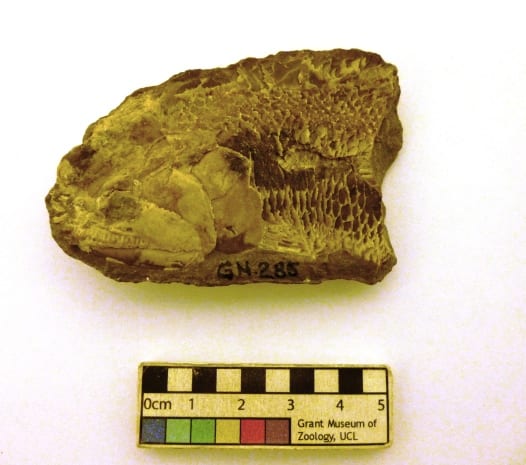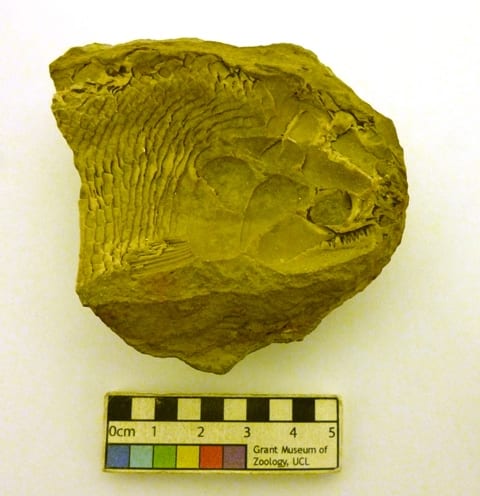Underwhelming Fossil Fish of the Month: January 2015
By Mark Carnall, on 30 January 2015
Ladies and gentlemen, boys and girls, children of all ages. The Grant Museum proudly brings to you, the monthly blog series nobody is talking about. The underwhelmingest fossil fish. Occasional photos of the reverse of fossils. The underwhelming fossil fish of the month! This month, as with every month we’ve got exclusive content right here for January 2015. Now, normally I like to keep it low key. A bit hush hush. A bit dress-down. Not too much to get excited over. A little bit, how shall we say, “meh”. However, rifling through the drawers to find this month’s fossil star I was stopped mid-rifle by this specimen. It’s going to be a real challenge to keep this one underwhelming. People of all persuasions and orientations, lock up your partners and significant others because this month we’ve got a real looker of a fossil fish to kick start the year.
I’m excited. Are you excited? Steel yourself for a swoon, here’s this month’s underwhelming fossil fish.
What a beauty! According to the label for this specimen, this is a specimen of Perleidus, a genus of predatory Triassic fish that have been found worldwide. Not that we can see it here with this chunk of hunk (slab-e of babe?) but these fish had flexible dorsal and anal fins which has been interpreted to mean these were highly agile fish in the water. According to the always reliable, never misleading label, this heart breaker comes from the very specific locality of river 13, Spath Plateau, Cape Stosch, Østgrønland, one of the three counties of Greenland until 2008 (now the country is divided into four municipalities). Perleidus is a genus of ray-finned fishes in the extinct group perleidiforms. Perleidiform fish are thought to have had skeletons primarily composed of cartilage. This one’s a well traveled specimen, carrying labels and numbers from the Greenland Geological Survey, ‘Cambridge University Zoology Department’ and numbers associated with D.M.S Watson, former curator of the Grant Museum and palaeoichthologist extraordinaire.
Preservation Oh ho ho! If this fossil wasn’t enough for you, it has an equally beautiful and naked twin (also known as the counterpart) who makes up for what they don’t have in scales with an exquisite set of gnashers (teeth for those from outside the UK).
This specimen is beautifully preserved as the nucleus in a calcareous concretion. Concretions are rounded nodules that form by mineral cement permeating through soil or rock. Sometimes they form around a nucleus which can be animal or plant remains. Nodules tend to be harder than their surrounding rock and can weather out, like a large palaeobiological Kinder Egg except without the toy or the chocolate and sometimes with a fossil inside. Oddly, we only have the front half of the concretion and the fish here. From the broken edge it looks like it was formed as a larger complete concretion but it may have been that the rear end of both the concretion and the fish were lost in the process of gently excavating this fossil with the skilled whack* of a geological hammer. It looks like this fish has been partially flattened during preservation, some of the scales from the right side have been flattened into the same plane as the left side but the head and the jaw are partially preserved in 3D. The arrangement of scales, part of the fins and the anatomy of the head can all be seen.
Research Last month’s underwhelming fossil fish of the month ended up with me finding that the fossil had been published. This month our fossil has a reference written on the label, which is helpful, but unfortunately, I’ve not been able to track down a copy of NIELSEN, E. 1936. Some few preliminary remarks on Triassic Fishes from East Greenland. Meddelelser om Grønland 112(3), 1–55. which may just be a reference to this genus but might possibly reference the specimen directly as this specimen was at collected by the Geological Survey of Greenland. Beyond the specimen itself, Perleidus is one of those bit part players in fossil fish scholarship, often mentioned in the context of explorations of other more interesting fossil fish, but never the bride.
In Society As the expression goes, a beautiful fossil fish in the hand is a guaranteed ticket to Hollywood. Perleidus appears on a 1999 Sahrawi Arab Democratic Republic stamp, which is when you know you’ve made it. I for one think this specimen deserves to to star in it’s own film. Perhaps a deep-time Jaws prequel? I wonder what that might look like?

Concept image of the poster for Jaws Zero, a documentary about the evolution of jaws in chondrostean fish, starring Perleidus. Poster by up and coming artist Mark Carnall, also available for other Powerpoint-based commissions and freelance palaeo-design work. The brown ball is supposed to be removed top soil, obviously.
Perleidus sp.
Preservation 8
Research 2+?
In Society 10 IN THEATRES NEAR YOU SOON until then 4
Underwhelmingness 4
References
NIELSEN, E. 1936. Some few preliminary remarks on Triassic Fishes from East Greenland. Meddelelser om Grønland
112(3), 1–55.
* There is a knack to the whack. Concretions that have formed around fossils which are preserved more or less in one flat plane do, with a skilled tap, tend to split nicely to reveal a beautiful fossil and corresponding counter part. Sometimes however, they fall to bits and the professional thing to do is to brush off the fragments and pretend that you were intending to destroy the nodule in a random act of geovandalism all along.
Mark Carnall is the Curator of the Grant Museum of Zoology
3 Responses to “Underwhelming Fossil Fish of the Month: January 2015”
- 1
-
2
Underwhelming Fossil Fish of the Month: March 2015 | UCL UCL Museums & Collections Blog wrote on 31 March 2015:

[…] is in four pieces and rather beautifully preserved inside a calcareous nodule as with one of our previous underwhelming fossil fish which was also collected from Greenland. Unfortunately, the head appears to have undergone some decomposition, bits of the jaws can be seen […]
-
3
Underwhelming Fossil Fish of the Month: December 2015 | UCL Museums & Collections Blog wrote on 23 December 2015:

[…] year started off on an uncharacteristic handsome note and the much celebrated return of SPOT THE FOSSIL FISH for February. March was meh. April was all […]
 Close
Close




Well, Mark, I think you may have a blockbuster here! What an idea for a reboot – JAWS ZERO! I have a couple of connections in Hollywood, so I think your people should talk to my people and we can do brunch.